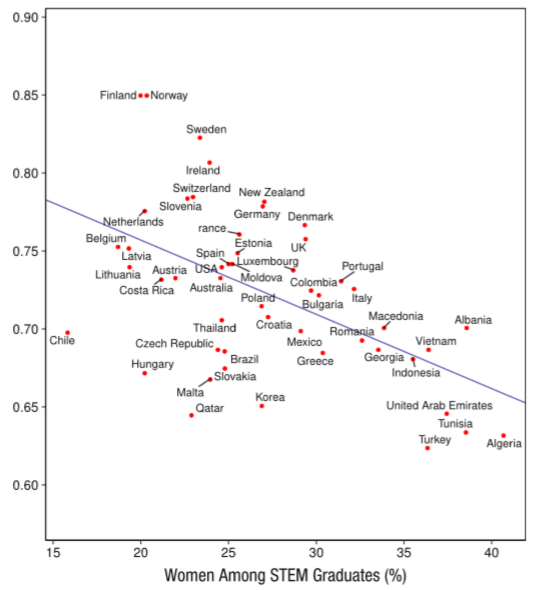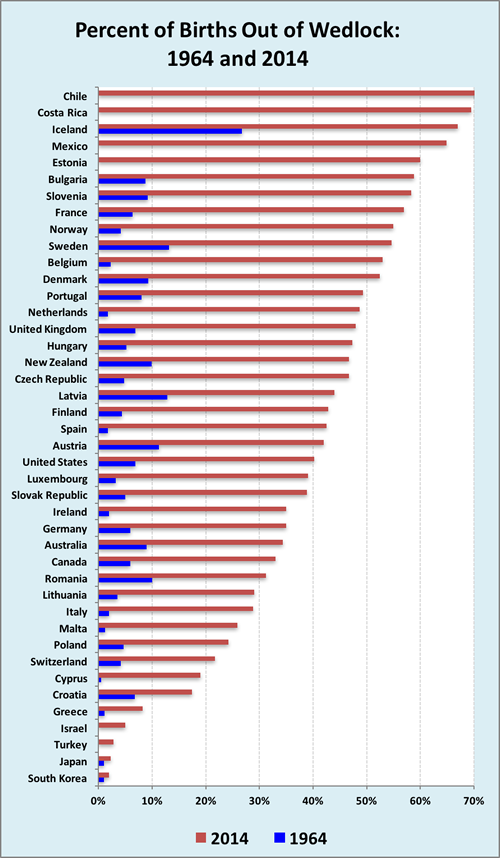Thanks SparWeb. I linked that article earlier, but I think the link may have gotten lost in the shuffle.
I'm surprised Pamela didn't find it on her google search. When I drop "The countries with the highest female STEM participation are middle eastern countries" into Google, it's the second hit. This could quite possibly be an artifact of how
Google tailors people's search results to their political biases. When I put
that phrase into google, this is my second hit:
which states:
article said:
"Suggested stories are selected by computer algorithms based on your past activity on Google," the company says.
In other words, we are so far down the rabbit hole in 2019 that a thread full of totally rational people can have extreme disagreements about a topic purely because Google is feeding us all different starting data, and we're all equally and properly applying logic to a different set of givens. This is a major problem with the divisiveness of modern discourse, by the way. Imagine how nasty this very discussion would be if it were among non-engineers.
Back on topic. The Atlantic article references this study:
The graph from the Atlantic article is less than ideal, because they don't label the Y axis at all (which by the way is the gender gap ratio) and they don't show an R^2 for the trendline. But presuming the data pool is reasonably well correlated linearly, as the study suggests, we see two important things:
1) Seven of the top eight countries in the world in terms of women in STEM are Muslim, and the outlier in that group is Vietnam. (which, fun fact, is surprisingly close to 0% Muslim)
2) Six of the bottom seven countries in the world in terms of women in STEM are European socialist democracies with high gender equality. The outlier in this group is Chile.
2b) If we widen the bottom group to 15 countries, 12 are European social democracies, and only one (Qatar) is Muslim.
While I understand the thinking behind this:
IRStuff said:
Until the playing field is truly level, and all biases are truly removed can we then determine whether a 50/50 ratio is plausible.
...the bias argument simply doesn't fit the data. From the study's abstract:
abstract said:
A mediation analysis suggested that life-quality pressures in less gender-equal countries promote girls’ and women’s engagement with STEM subjects.
Which is similar to this phrase from hokie66:
hokie66 said:
The Scandinavian outliers have generous social welfare systems, so women don't need to strive so hard to achieve their desired lifestyles
Which is another way of saying this:
beej67 said:
If you apply Occam's Razor, the simplest cleanest explanation is that in places where your income is the least tied to your occupation, women choose STEM the least. When the money doesn't matter, they largely choose professions that have to do with people instead of things, on a statistical basis. Because of scientifically measurable biological differences in the statistical distributions of personality traits. Not because of "society" or whatever.
It's a choice thing. Women choose STEM more when the money gives them more incentive, and would choose STEM less if the money didn't matter.
That's of course not to say "all." My wife is an engineer, and my best female friend was an engineer, before she decided to become a housemom instead. I also know four other women from my university days with engineering degrees. Only one is an engineer, and she is a talented one. Several are housemoms who never even began down the engineering path. The housemoms could have certainly been great engineers if they chose to do so, but I doubt they chose housemom due to sexism in the workplace. Most of them were never even exposed to the workplace. Now I will grant those are all anecdotes, not data, but the data is above and seems to match up.
Now I happen to think there is some cultural stuff going on, but not on a "society at large" level, but rather at a business level. And not necessarily with sexism either. I'm incredibly fortunate that I run my own business. My wife is currently dying of cancer, and we have two small children, so the uncertainty of that situation caused me to explore entering the job market recently. What I discovered, basically, was that there were
zero engineering firms willing to work with a single parent's schedule. If I went back to work for a big firm, I would be earning money to pay a nanny, instead of raising my kids myself. This trap I find myself in, is the same trap that all single parents find themselves in, and 80% of single parents are women. So that has
got to figure in the STEM gap somewhere. In fact, it may very well figure into not only our STEM gap domestically, but also the STEM gap in the graph, because there are very, very few single moms in Muslim countries and quite a lot of single moms in Scandinavia. Quite honestly I'm surprised the researchers didn't pick up on this possible confounder.
Look at this:
Holy crap, it even explains the Chile outlyer, and why Costa Rica is in there with the Nordic countries.
Someone should do a study on this.
Hydrology, Drainage Analysis, Flood Studies, and Complex Stormwater Litigation for Atlanta and the South East -



